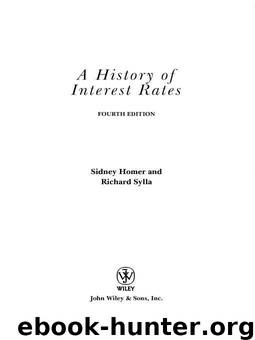A History of Interest Rates (Wiley Finance) by Homer Sidney & Sylla Richard

Author:Homer, Sidney & Sylla, Richard [Homer, Sidney]
Language: eng
Format: epub
Publisher: Wiley
Published: 2007-12-09T23:00:00+00:00
1830-1859. The history of the national debt during this thirty-year period may be divided into three parts: (a) redemption of the entire remaining debt, 1830-1835; (b) no debt, 1835-1842; and (c) creation of a new debt, 1842-1859. The total national debt from 1800 fluctuated as follows:
During the period of final debt redemption, 1830-1835, the trend of government bond yields was downward, as might be expected. Examination of the market for City of Boston 5s which ranged between 4.79 and 5.02% suggests that the true level of market yields may have changed very little during this period, and that the low redemption yields on premium governments reflected merely the possibility that they might not be redeemed promptly.
By January of 1835 the debt was wiped out. From 1835 to 1841 there were no government bonds outstanding and hence no government bond yields for history to record. However, issues of the City of Boston and the State of Massachusetts were quoted regularly, and these yields may be taken as a help in judging market levels and trends. The possibility of special privileges and the effects of local financial preferences make it impossible to draw firm conclusions on national market trends from the prices of one or two local issues.
Boston yields were about the same in 1835, when the federal debt was wiped out, as they were in 1830; this reinforces the view that there was little change in going rates of long-term interest during this five-year period of debt redemption. During the years 1835-1841, when there were no treasury issues outstanding, the yields on local issues rose. A rise in market yields is also suggested by the fact that the first government financing in 1841-1842 took the form of 6s, while the issues redeemed in 1830-1835, which commanded premiums, were mostly 5s and 4½s.
This seven-year debtless interval was in fact one of great financial disturbance. The second Bank of the United States had lost its charter, and federal deposits had been transferred to state banks. A period of wild speculation had ended in the collapse of 1837, which had been succeeded by a heavy depression. Treasury surpluses quickly gave way to deficits.
From 1837 to 1841 the Treasury financed its deficits entirely through the sale of about $40 million of notes without recourse to long-term loans. The idea of a new national debt for peacetime purposes met widespread political opposition; the notes were considered a temporary expedient. With a change in administration in 1841 a new policy of funding notes into longer-term bonds was inaugurated. The first loan, which was redeemable in only three years, was not a success and had to be broken up into two parts:
Download
This site does not store any files on its server. We only index and link to content provided by other sites. Please contact the content providers to delete copyright contents if any and email us, we'll remove relevant links or contents immediately.
International Integration of the Brazilian Economy by Elias C. Grivoyannis(90793)
The Radium Girls by Kate Moore(11921)
Turbulence by E. J. Noyes(7935)
Nudge - Improving Decisions about Health, Wealth, and Happiness by Thaler Sunstein(7615)
The Black Swan by Nassim Nicholas Taleb(7010)
Rich Dad Poor Dad by Robert T. Kiyosaki(6399)
Pioneering Portfolio Management by David F. Swensen(6226)
Man-made Catastrophes and Risk Information Concealment by Dmitry Chernov & Didier Sornette(5921)
Zero to One by Peter Thiel(5685)
Secrecy World by Jake Bernstein(4643)
Millionaire: The Philanderer, Gambler, and Duelist Who Invented Modern Finance by Janet Gleeson(4374)
The Age of Surveillance Capitalism by Shoshana Zuboff(4209)
Skin in the Game by Nassim Nicholas Taleb(4161)
Bullshit Jobs by David Graeber(4094)
The Money Culture by Michael Lewis(4075)
Skin in the Game: Hidden Asymmetries in Daily Life by Nassim Nicholas Taleb(3929)
The Dhandho Investor by Mohnish Pabrai(3698)
The Wisdom of Finance by Mihir Desai(3650)
Blockchain Basics by Daniel Drescher(3504)
